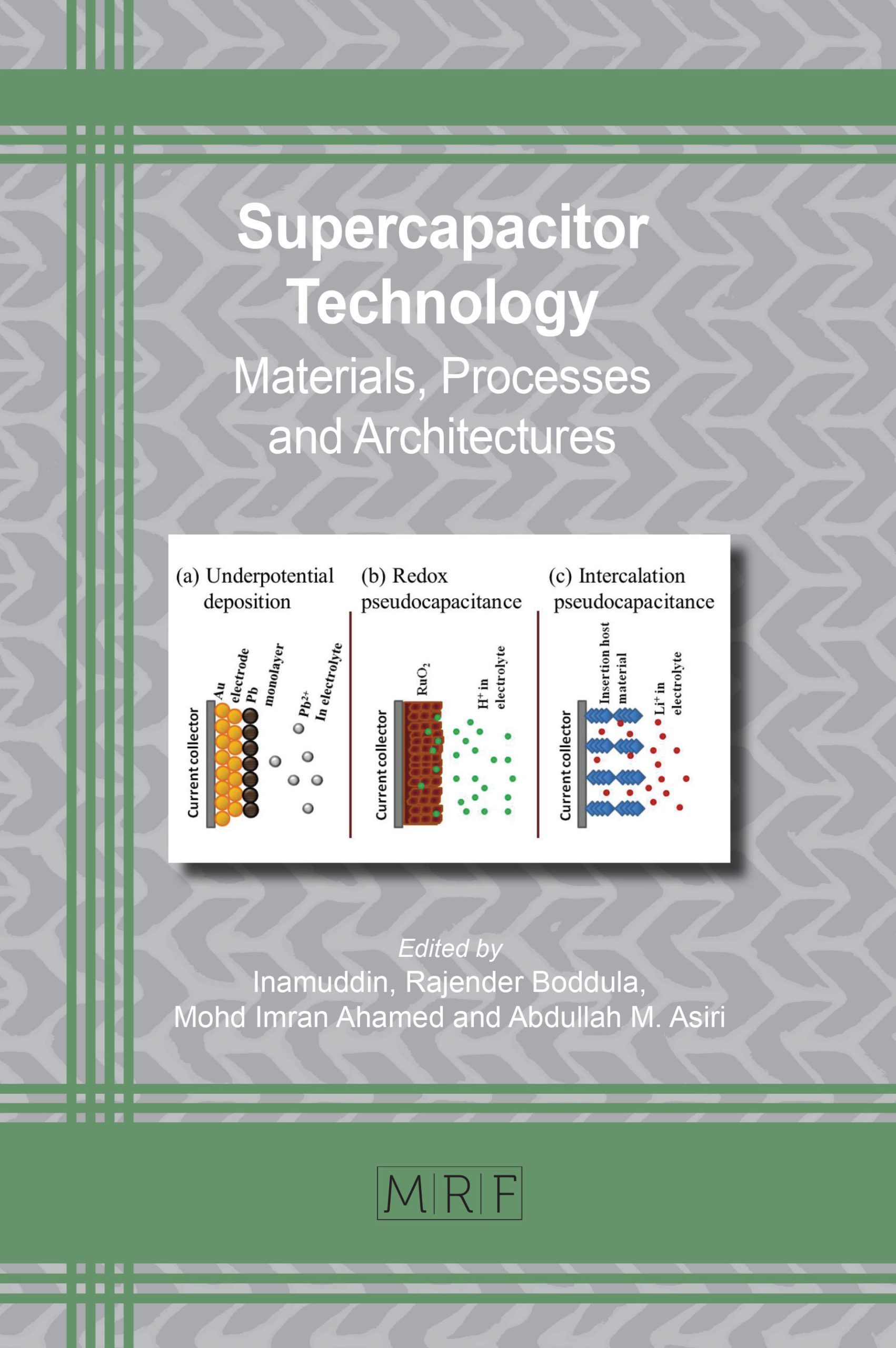Organic Electrolytes for Supercapacitors
Ivy Heng, Chin Wei Lai, Joon Ching Juan
Organic electrolytes can provide comprehensive opportunities for assembling high-energy supercapacitors because of their wide potential windows. The most conventional organic electrolytes are acetonitrile and propylene carbonate. The detailed review of different types of solvents and salts present in organic electrolytes are discussed through extensive analysis of the literature. This chapter intends to provide an overall assessment of organic electrolytes in use in present supercapacitor applications. Several possible oversights for the rational selection of future organic electrolytes are proposed for supercapacitor devices.
Keywords
Organic Electrolytes, Solvents, Solutes, Acetonitrile, Propylene Carbonate, Tetrafluoroborate
Published online 11/5/2019, 10 pages
Citation: Ivy Heng, Chin Wei Lai, Joon Ching Juan, Organic Electrolytes for Supercapacitors, Materials Research Foundations, Vol. 61, pp 1-10, 2019
DOI: https://doi.org/10.21741/9781644900499-1
Part of the book on Supercapacitor Technology
References
[1] A. Balducci, Electrolytes for high voltage electrochemical double layer capacitors: A perspective article, J. Power Sources 326 (2016) 534-540. https://doi.org/10.1016/j.jpowsour.2016.05.029
[2] A. Brandt, S. Pohlmann, A. Varzi, A. Balducci, S. Passerini, Ionic liquids in supercapacitors, MRS bull. 38 (2013) 554-559. https://doi.org/10.1557/mrs.2013.151
[3] K. Chiba, T. Ueda, Y. Yamaguchi, Y. Oki, F. Shimodate, K. Naoi, Electrolyte systems for high withstand voltage and durability I. Linear sulfones for electric double-layer capacitors, J. Electrochem. Soc. 158 (2011) A872-A882. https://doi.org/10.1149/1.3593001
[4] X. Sun, C.A. Angell, Doped sulfone electrolytes for high voltage Li-ion cell applications, Electrochem.Commun.11 (2009) 1418-1421. https://doi.org/10.1016/j.elecom.2009.05.020
[5] K. Naoi, ‘Nanohybrid capacitor’: the next generation electrochemical capacitors, Fuel cells 10 (2010) 825-833. https://doi.org/10.1002/fuce.201000041
[6] A. Brandt, P. Isken, A. Lex-Balducci, A. Balducci, Adiponitrile-based electrochemical double layer capacitor, J. Power Sources 204 (2012) 213-219. https://doi.org/10.1016/j.jpowsour.2011.12.025
[7] H. Duncan, N. Salem, Y. Abu-Lebdeh, Electrolyte formulations based on dinitrile solvents for high voltage Li-ion batteries, J. Electrochem. Soc. 160 (2013) A838-A848. https://doi.org/10.1149/2.088306jes
[8] M. Nagahama, N. Hasegawa, S. Okada, High voltage performances of Li2NiPO4F cathode with dinitrile-based electrolytes, J. Electrochem. Soc.157 (2010) A748-A752. https://doi.org/10.1149/1.3417068
[9] R.-S. Kühnel, N. Böckenfeld, S. Passerini, M. Winter, A. Balducci, Mixtures of ionic liquid and organic carbonate as electrolyte with improved safety and performance for rechargeable lithium batteries, Electrochim. Acta 56 (2011) 4092-4099. https://doi.org/10.1016/j.electacta.2011.01.116
[10] S. Yoon, Y.-H. Lee, K.-H. Shin, S.B. Cho, W.J. Chung, Binary sulfone/ether-based electrolytes for rechargeable lithium-sulfur batteries, Electrochim. Acta 145 (2014) 170-176. https://doi.org/10.1016/j.electacta.2014.09.007
[11] P. Porion, Y.R. Dougassa, C. Tessier, L. El Ouatani, J. Jacquemin, M. Anouti, Comparative study on transport properties for LiFAP and LiPF6 in alkyl-carbonates as electrolytes through conductivity, viscosity and NMR self-diffusion measurements, Electrochim. Acta 114 (2013) 95-104. https://doi.org/10.1016/j.electacta.2013.10.015
[12] M. Dahbi, F. Ghamouss, F. Tran-Van, D. Lemordant, M. Anouti, Comparative study of EC/DMC LiTFSI and LiPF6 electrolytes for electrochemical storage, J. Power Sources 196 (2011) 9743-9750. https://doi.org/10.1016/j.jpowsour.2011.07.071
[13] G. Wang, L. Zhang, J. Zhang, A review of electrode materials for electrochemical supercapacitors, Chem. Soc. Rev. 41 (2012) 797-828. https://doi.org/10.1039/C1CS15060J
[14] C. Zhong, Y. Deng, W. Hu, J. Qiao, L. Zhang, J. Zhang, A review of electrolyte materials and compositions for electrochemical supercapacitors, Chem. Soc. Rev. 44 (2015) 7484-7539. https://doi.org/10.1039/C5CS00303B
[15] J. Krummacher, C. Schütter, L. Hess, A. Balducci, Non-aqueous electrolytes for electrochemical capacitors, Curr. Opinion Electrochem. 9 (2018) 64-69. https://doi.org/10.1016/j.coelec.2018.03.036
[16] F. Cheng, X. Yu, J. Wang, Z. Shi, C. Wu, A novel supercapacitor electrolyte of spiro-(1, 1′)-bipyrolidinium tetrafluoroborate in acetonitrile/dibutyl carbonate mixed solvents for ultra-low temperature applications, Electrochim. Acta 200 (2016) 106-114. https://doi.org/10.1016/j.electacta.2016.03.113
[17] S. Park, K. Kim, Tetramethylammonium tetrafluoroborate: The smallest quaternary ammonium tetrafluoroborate salt for use in electrochemical double layer capacitors, J. Power Sources 338 (2017) 129-135. https://doi.org/10.1016/j.jpowsour.2016.10.080
[18] J. Han, N. Yoshimoto, Y.M. Todorov, K. Fujii, M. Morita, Characteristics of the electric double-layer capacitors using organic electrolyte solutions containing different alkylammonium cations, Electrochim. Acta (2018). https://doi.org/10.1016/j.electacta.2018.06.012
[19] X. Yu, D. Ruan, C. Wu, J. Wang, Z. Shi, Spiro-(1, 1′)-bipyrrolidinium tetrafluoroborate salt as high voltage electrolyte for electric double layer capacitors, J. Power Sources 265 (2014) 309-316. https://doi.org/10.1016/j.jpowsour.2014.04.144
[20] S. Nakata, Characteristic of an adiabatic charging reversible circuit with a Lithium ion capacitor as an energy storage device, Results Phys. 10 (2018) 964-966. https://doi.org/10.1016/j.rinp.2018.08.016
[21] L. Zhang, Y. Zhu, W. Zhao, L. Zhang, X. Ye, J.-J. Feng, Facile one-step synthesis of three-dimensional freestanding hierarchical porous carbon for high energy density supercapacitors in organic electrolyte, J. Electroanal. Chem. 818 (2018) 51-57. https://doi.org/10.1016/j.jelechem.2018.04.031
[22] K.Ö. Köse, B. Pişkin, M.K. Aydınol, Chemical and structural optimization of ZnCl2 activated carbons via high temperature CO2 treatment for EDLC applications, Int J Hydrogen Energy 43 (2018) 18607-18616. https://doi.org/10.1016/j.ijhydene.2018.03.222
[23] S.-M. Li, S.-Y. Yang, Y.-S. Wang, H.-P. Tsai, H.-W. Tien, S.-T. Hsiao, W.-H. Liao, C.-L. Chang, C.-C.M. Ma, C.-C. Hu, N-doped structures and surface functional groups of reduced graphene oxide and their effect on the electrochemical performance of supercapacitor with organic electrolyte, J. Power Sources 278 (2015) 218-229. https://doi.org/10.1016/j.jpowsour.2014.12.025
[24] P. Pazhamalai, K. Krishnamoorthy, S. Manoharan, S.-J. Kim, High energy symmetric supercapacitor based on mechanically delaminated few-layered MoS2 sheets in organic electrolyte, J. Alloys Compd. 771 (2019) 803-809. https://doi.org/10.1016/j.jallcom.2018.08.203
[25] Z. Liu, H. Zhang, Q. Yang, Y. Chen, Graphene/V2O5 hybrid electrode for an asymmetric supercapacitor with high energy density in an organic electrolyte, Electrochim. Acta 287 (2018) 149-157. https://doi.org/10.1016/j.electacta.2018.04.212
[26] A.M. Navarro-Suárez, K.L. Van Aken, T. Mathis, T. Makaryan, J. Yan, J. Carretero-González, T. Rojo, Y. Gogotsi, Development of asymmetric supercapacitors with titanium carbide-reduced graphene oxide couples as electrodes, Electrochim. Acta 259 (2018) 752-761. https://doi.org/10.1016/j.electacta.2017.10.125
































